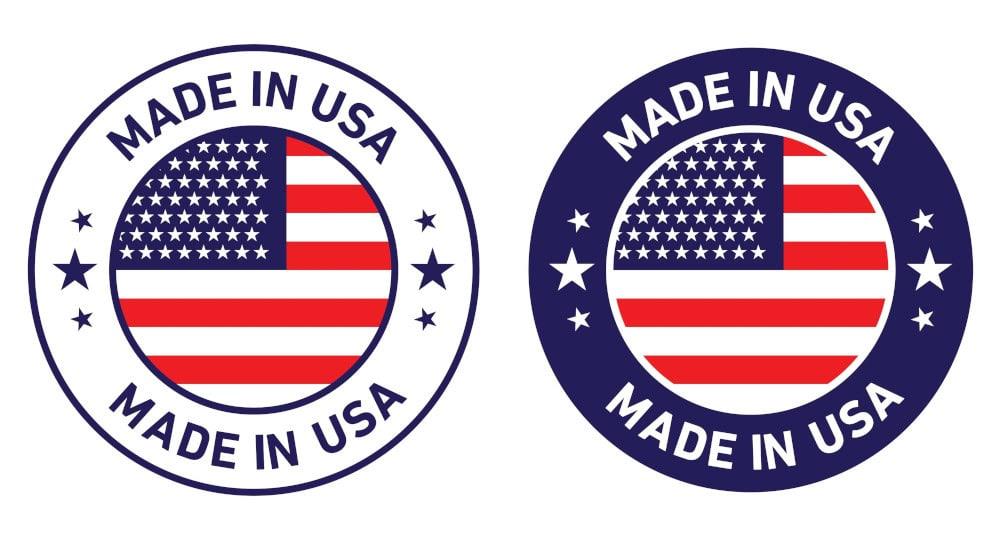Made in America—a matter of patriotism, but also (sometimes) the law
Many Americans want to spend money on high-quality American goods to support US businesses and create real, good jobs for their neighbors. In some cases, buying American-made goods can also be the law.
If you work for the federal government or if you’re doing work with federal funds, you’re probably bound by at least one of the ‘BA rules’ focused on domestic procurement. Depending on where you work and what you’re building, the Buy American Act of 1933, the ‘Buy America Act’ of 1982, and the Build America, Buy America Act of 2021 might mean you must purchase goods and materials predominantly manufactured in America or by one of America’s allies.
If you need American-made supplies for your next fire protection project, this guide explains how to do it. Read on to learn:
- The difference between Buy American, Buy America, and Build America, Buy America (and how to know which one applies to your situation)
- How to ensure a supplier complies with the relevant rules and prove it
- Finding American-made fire protection materials
Need to buy American? QRFS is your partner. Contact our customer service team at 888-361-6662 or support@qrfs.com, and we’ll help you identify the right products for your needs.
Understanding Buy American, Buy America, and Build America, Buy America
The laws surrounding “made in American” procurement for federal work have some confusing names. There are three main laws: the 1933 Buy American Act, the ‘Buy America Act’ (Officially, Section 165 of the 1982 Surface Transportation Assistance Act), and the 2021 Build America, Buy America Act. Yes, these are three different laws. For convenience, we’ll refer to the three together as “BA rules.”
Despite their similar names, each law applies to different situations and has different procurement rules. Here’s the 10-second breakdown:
- Buy American relates to work procured by the federal government (plus Washington, DC, and the US Territories)
- Buy America is for transport projects funded by federal awards
- Build America, Buy America regards infrastructure projects funded by federal awards
Easy, right? Here’s how it’s a bit more complicated.
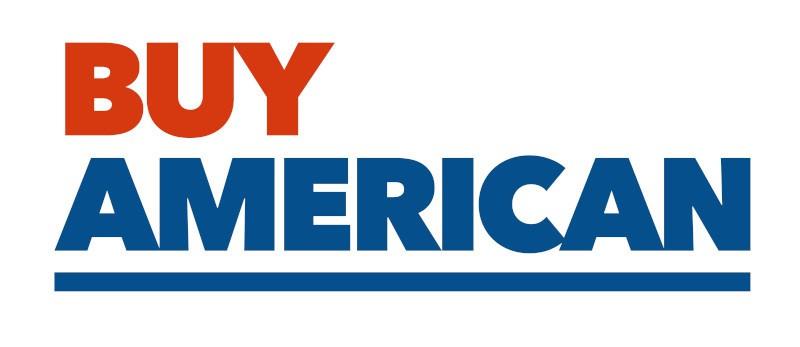
Buy American is for projects the federal government completes
The Buy American Act (BAA) was signed into law by Herbert Hoover on his last full day as president in 1933. Hoover hoped to boost the US economy during the Great Depression by ensuring the federal government spent its dollars domestically. Ultimately, a surge of federal spending on domestic production did supercharge America’s economy—but that was because of World War II.
This law applies to procurement the federal government does itself, for its own projects. The District of Columbia and the US territories of Puerto Rico, American Samoa, and the US Virgin Islands are also bound by “Buy American.” Work performed by organizations (states, municipalities, or private companies) funded by federal money is not included.
The main thrust of the Buy American Act is this: anything purchased for the federal government must be manufactured in America, and the material contents of the goods must be substantially mined, produced, or manufactured in America. The last point—what is considered “substantially”—is complicated; Buy American rules calculate this threshold based on the cost of each component of a manufactured product. Currently, a ‘widget’ qualifies as American-made if 65% of the cost to make it comes from American-made or American-extracted parts. By 2029, this proportion will increase to 75%.
Confused? An example will help. Imagine that a new federal building needs a sprinkler system with electronically supervised valves. The system needs valves that cost, say, $500 each. Suppose that the metal body of the valve comes from US-mined and refined metal, but the rubber and electrical components are imported. The valve could only meet Buy American requirements if the metal made up at least 65%, or $325, of the valve’s total cost.
Buy American has always had exceptions, however. For one, if any made-in-America supplies cost over 25% more than imported supplies, the law can be waived. The law can also be waived if domestic supplies aren’t available in the quality or quantity needed. Additionally, trade agreements can be allowable exceptions to these rules. For example, goods made in countries included in the World Trade Organization Agreement on Government Procurement (GPA) or a US Free Trade Agreement (FTA) may be exempt from Buy American rules. But if you are a provider for the government, you’ll have to confirm any exceptions with the federal agency that hires you.
‘Buy America’ is for federally funded transport projects
What’s often called “The Buy America Act” officially derives from the 1982 Surface Transportation Assistance Act. “Surface transportation” tells you the focus of Buy America: transportation infrastructure. Unlike Buy American, Buy America only applies to transportation projects funded by the federal government—think highways, bridges, and railroads. And not all procurement is covered here—only “iron, steel, manufactured products, and construction materials.”
Like Buy American, Buy America has some exceptions for close trade partners like Canada. Because Canada is a member of the US-Mexico-Canada (USMCA) trade agreement (formerly NAFTA), Canadian goods can sometimes be considered compliant.
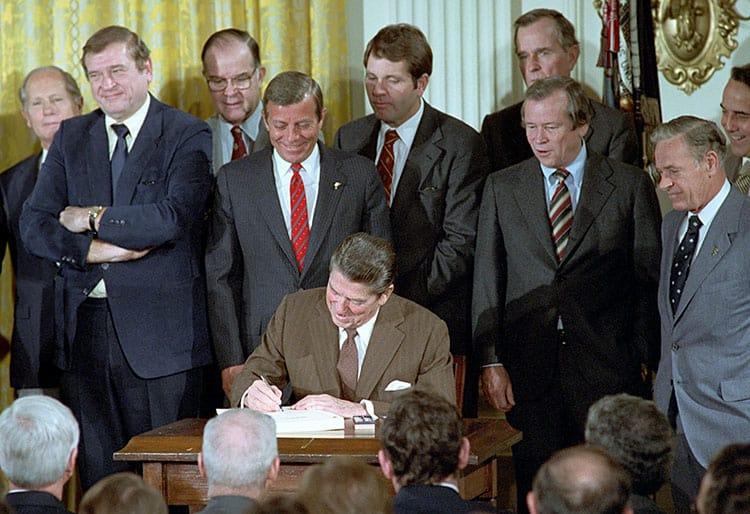
Build America, Buy America is for any federally funded infrastructure
The 2021 Build America, Buy America (BABA) Act expanded on the limited scope of the Buy America Act. Where Buy America only applied to federally-funded transportation projects, BABA covers all public infrastructure funded by federal awards.
“Infrastructure” is a deliberately broad term. The relevant law—2 CFR 184.4(c)—says it can mean:
- Roads, highways, and bridges
- Public transport
- Dams, ports, and harbors
- Passenger and freight rail
- Airports
- Water and wastewater facilities
- Electrical transmission facilities
- Buildings
This list is not exhaustive, and the law underscores this fact. When a federal agency grants a cash award for some kind of project, the agency is just supposed to consider “whether the project will serve a public function.” If it will serve a public function and determined “infrastructure,” the agency must enforce the Buy America preference.
Under BABA, the standards to meet slightly differ from the Buy American Act. BABA distinguishes between steel and iron products, manufactured products, and construction materials:
- Steel and iron products should be entirely made in the USA, from “the initial melting stage through the application of coatings.”
- For manufactured products, final manufacturing must occur in the USA, and 55% of the cost of the final product must come from components mined, produced, or manufactured in the USA.
- Construction materials must be entirely produced in the USA.
As with Buy American, BABA has exceptions. Someone can get a waiver if:
- The supplies you need aren’t available (in quality or quantity) domestically
- American-made supplies are excessively expensive (e.g., 25% more) compared to imported goods
- American-made supplies somehow don’t “serve the public interest”
How to prove compliance with ‘Made in America’ laws
If you’re working on a project needing made in America parts, you have to evaluate potential suppliers and prove compliance. If your client is a federal agency (under Buy American), the agency will require documentation. The same applies if your client uses federal funds (either Buy America or BABA)—you provide proof of compliance to the client, who provides it to their funding agency. But what does this documentation look like?
In short, the documentation you need is letters or certificates from suppliers guaranteeing a sufficient portion of the materials are made in America.
To get this letter, start with a comprehensive bill of materials—all the parts and supplies you’ll need for your project. With that list in hand, you can go to your suppliers and explain the laws and standards you must meet. Typically, reputable companies’ sales teams will tell you which parts meet the “Made in America” laws you have to follow—and give you a letter or certificate confirming that. The letter might be provided alongside the rest of the submittal documents you get from your supplier.
For example, Viking’s website provides a handy option to auto-generate this letter using a list of their qualifying parts (namely, valves). Here are two examples of these letters from two of QRFS’s partners: Viking and ASC Engineered Solutions. Typically, suppliers will write a single letter covering all the parts and materials they sell you to reduce the paperwork.
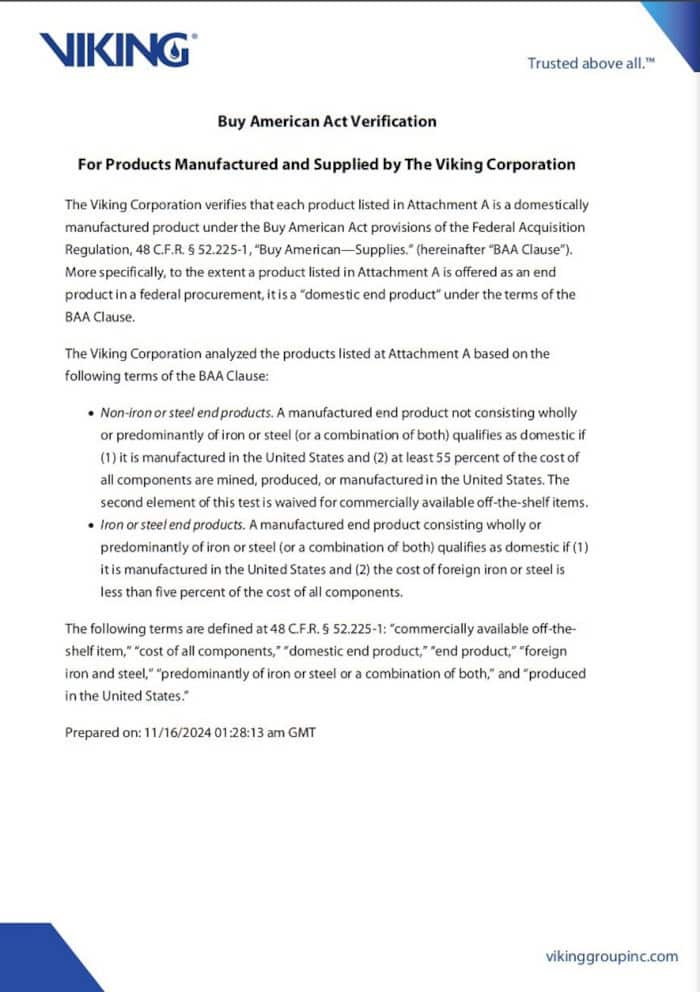
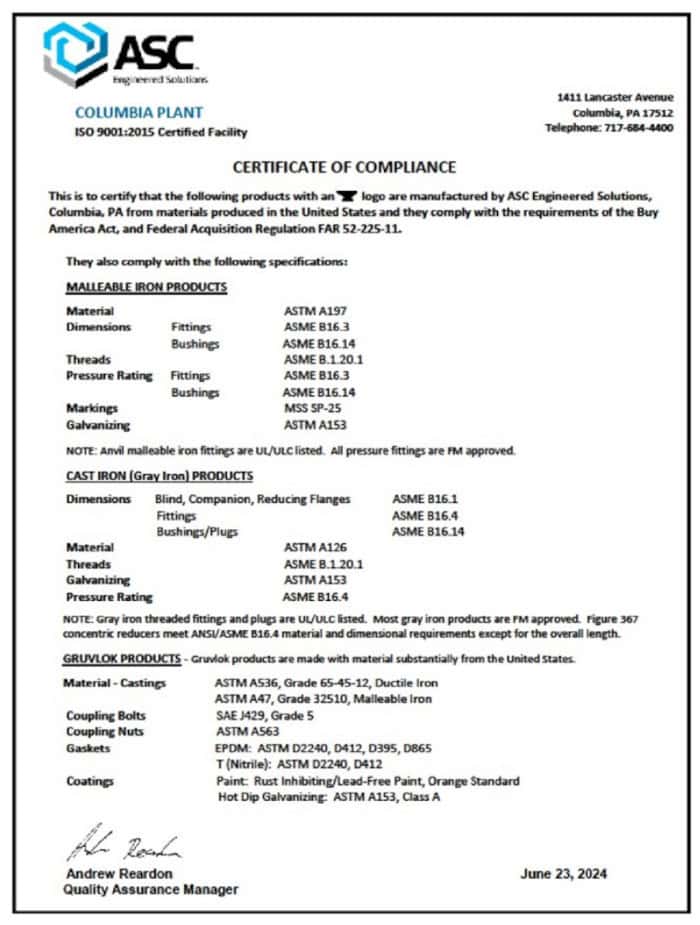
Finding American-made fire protection materials
Fortunately, it’s not hard to find suppliers that meet “made in America” rules in the fire protection world. American production can provide nearly everything you need for a piping system: pipe, joints, fittings, valves, and more. QRFS’s partner, ASC Engineered Solutions, is one great supplier of fire protection fabrication, flow control, and pipe joining products—all their factories are in the US.
American-made fire sprinklers are also readily available. Reliable manufactures all their sprinklers and valves in Liberty, South Carolina. Viking has a plant in Michigan, and Tyco has a plant in Texas. Victaulic is headquartered in Easton, PA, and has manufacturing facilities in the US.
Regardless, complying with BA laws is not as simple as knowing where the factory is. Remember, there are rules for the source of components of a finished product, and these rules depend on the relative price of all the materials. Viking’s technical service team explained it this way: Supply chains are variable, so the source and the cost of different components can change. This can impact the made-in-America status of an item.
Here are three examples of how that might work:
- Imagine that tomorrow, a hurricane destroys the main factory in the US that makes heat-sensitive glass bulbs for sprinklers. Because of this, a sprinkler manufacturer might have to switch to an overseas supplier. Then, they would have to recalculate what percentage of the cost of their sprinklers is made in America.
- Or, say the US government announces massive deregulation and subsidies for copper mining and metallurgy. Consequently, the price of the brass used to make many sprinkler frames drops massively. Could the price get so low that, by cost-percentage, sprinklers would no longer qualify as made in America? It’s possible.
- Finally, imagine that tariffs—some of which are expected with an incoming administration—make certain imported components more expensive. Could that price change cause sprinklers to lose “made in America” compliance status because of their lesser proportional cost? It’s also possible.
This variability of supply chains means that you should always ask your supplier about “Buy American” compliance at the time of purchase. Doing so ensures their certificates of compliance are accurate at that moment.
Also, it bears repeating that all “BA” laws have different exceptions for the feasibility of procurement, quality, excessive cost, and trade partners friendly to the USA. If there’s a component you need for a fire protection system that genuinely can’t be obtained while meeting the standards of the relevant BA law, your client or funding agency may help you navigate the requirements.
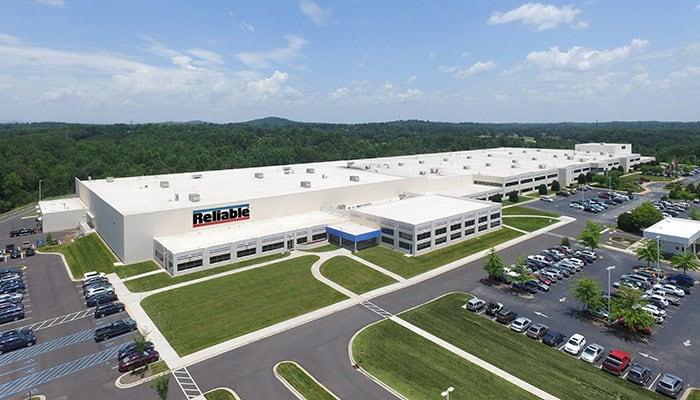
There is an excellent selection of made-in-America fire protection equipment
If your contract has procurement requirements, or you simply want to buy equipment made in the USA, don’t worry! There’s no shortage of largely American-produced pipes, valves, fire sprinklers, and more. Complying with the ‘Made in America’ rules is often as simple as doing a little research and asking your supplier for a certificate or letter.
QRFS is ready to help with compliance. If your next job has American-made requirements, get in touch with our customer service team. We’ll help you source qualifying parts from our partnerships and vast catalog of fire sprinklers, pipes, fittings, valves, and more.
This blog was originally posted at blog.qrfs.com. If this article helped you, check us out on Twitter @QuickResponseFS.


